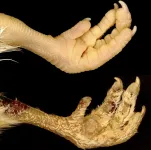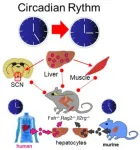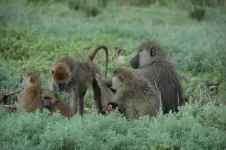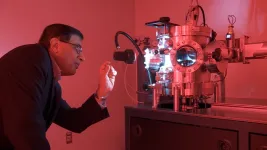(Press-News.org) Australian nanomedicine researchers have come up with a new approach to solving a decades-old clinical problem: getting treatment drugs to act selectively on cancer cells in the body. Published this week in the high-impact journal Science Translational Medicine, the research paves the way to safer and more effective treatment options for children with aggressive blood cancers, and potentially other types of cancer as well.
Chemotherapy is the mainstay of treatment for leukaemia, the most common blood cancer in children. However, while chemotherapy can be very effective for certain types of leukaemia, it is not as effective for some other types, known as ‘high-risk’ leukaemias. Treatment for high-risk leukaemias generally involves high doses of toxic drugs that flood the body, indiscriminately affecting cancer cells and healthy cells alike. This often leads to severe side effects, as well as lifelong health issues in survivors.
“Finding a way to make treatment drugs act more selectively on cancer cells is the key to improving treatment success while reducing toxicity in children treated for high-risk leukaemia,” said Professor Maria Kavallaris AM, Head of the Translational Cancer Nanomedicine theme at Children’s Cancer Institute, who led the research. “By specifically targeting leukaemia cells, we can make treatment more effective, as well as much safer to use in children.”
In the newly published research, scientists at Children’s Cancer Institute and collaborating organisations used a special formulation of the cancer drug, doxorubicin (Caelyx), in which the drug is encapsulated in tiny particles called liposomes. To this formulation, they added ‘bi-specific antibodies’ – antibodies capable of recognizing and attaching to the drug at one end and to cancer cells at the other end, effectively acting as a bridge between the two. Known as a ‘targeted drug delivery system’, this acts to deliver the drug to its target, in this case leukaemia cells, where the drug can do its job and kill the cells.
“What is particularly useful about this new approach is its flexibility,” explained lead author, Dr Ernest Moles, Research Fellow at Children’s Cancer Institute. “We can use this system to target any leukaemia, including the high-risk subtypes that are killing Australian children every year. Rather than having to design a completely new therapeutic each time, all we need do is change the antibody bridge, and we can target the same drug to any child’s blood cancer.”
“What’s more, this approach could allow us to counter drug resistance in an individual patient. If the cancer cells in a child try to evade chemotherapy by altering their cell surface, we can modify the targeted drug delivery system so it is able to recognise that altered cancer cell. There will be no easy escape.”
The new approach was shown to work well not only in leukaemia cells grown in the laboratory, but also in living models of the disease. In these models, the targeted drug delivery system was found not only to reduce the amount of leukaemia, but also to significantly prolong survival – in some cases, up to four-fold.
The researchers believe this same approach could be used to improve the selectivity of a whole range of new-generation therapeutic agents, not just chemotherapy drugs, opening the way to offering children alternative therapeutic options that are much safer than those currently on offer. They are also excited about the potential contribution it could make in the dawning era of precision medicine.
“In the future, it may be that each child diagnosed with leukaemia can have their treatment targeted to their specific subtype, based on the analysis of a blood sample,” said Professor Kavallaris.
“We believe the controlled targeting of nanotherapeutics represents a real milestone in the treatment of childhood cancers, and we’re very optimistic about where this could lead to.”
Matt Weston and his son Jacob, who is currently being treated for acute lymphoblastic leukaemia, know all too well the significance of this research. “I’ve followed this research project closely, and I’ve been absolutely blown away by the work of Maria, Ernest and the team at Children’s Cancer Institute,” said Matt.
“Having experienced firsthand how toxic the chemo treatment is through my son's journey, I could tell you some horror stories of the side effects even with a standard risk diagnosis. For those with high-risk leukaemia, not only is the treatment far more toxic, but their chances of survival are much lower as well.
“I think about those children and their families all the time, and to know that we are closer to improving the treatment, reducing the toxicity, and improving their chances of survival gives me great hope.”
Jacob has already been through several cycles of chemotherapy over the past eight months, and has experienced a range of debilitating side-effects. But it’s not over yet. He has another 16 months of maintenance therapy to go, then it will be another three years beyond that before he gets the all-clear. “It’s a long road ahead,” says Matt. You can read more about Jacob’s story here.
Several institutions collaborated on the research, including Children’s Cancer Institute, University of Queensland, University of NSW Sydney, University of Western Australia, Curtin University, Prince of Wales Hospital, St Vincent's Hospital, Perth Children’s Hospital and Telethon Kids Institute. Key funding bodies included the National Health and Medical Research Council, Cancer Council NSW, and Tour de Cure.
END
Australian nanomedicine research a ‘milestone’ in the treatment of childhood cancer
Australian nanomedicine researchers have come up with a new approach to solving a decades-old clinical problem: getting treatment drugs to act selectively on cancer cells in the body
2023-05-17
ELSE PRESS RELEASES FROM THIS DATE:
Scales or feathers? It all comes down to a few genes
2023-05-17
Scales, spines, feathers and hair are examples of vertebrate skin appendages, which constitute a remarkably diverse group of micro-organs. Despite their natural multitude of forms, these appendages share early developmental processes at the embryonic stage. Two researchers from the University of Geneva (UNIGE) have discovered how to permanently transform the scales that normally cover the feet of chickens into feathers, by specificially modifying the expression of certain genes. These results, published in the journal Science Advances, open new perspectives for studying mechanisms that have enabled radical evolutionary ...
New study explains how a common virus can cause multiple sclerosis
2023-05-17
Researchers at Karolinska Institutet in Sweden have found further evidence for how the Epstein-Barr virus can trigger multiple sclerosis or drive disease progression. A study published in Science Advances shows that some individuals have antibodies against the virus that mistakenly attack a protein in the brain and spinal cord.
The Epstein-Barr virus (EBV) infects most people early in life and then remains in the body, usually without causing symptoms. The link between EBV and the neurological disease multiple sclerosis (MS) was discovered many years ago and has puzzled ...
Liver cells control our biological clock
2023-05-17
Organisms rely on a biological clock known as the ‘circadian’ clock to regulate their activity according to the time of day. A central clock, constituted by a group of brain cells — the suprachiasmatic nuclei, or SCN — synchronises the circadian clocks present in all body’s organs, called ‘peripheral’ clocks. Until now, synchronisation of the circadian cycle in mammals was thought to be a one-way mechanism in which the suprachiasmatic nuclei alone synchronized the peripheral ...
Adult friendships can triumph over childhood trauma, even in baboons
2023-05-17
DURHAM, N.C. -- Decades of research show that experiencing traumatic things as a child -- such as having an alcoholic parent or growing up in a tumultuous home -- puts you at risk for poorer health and survival later in life.
But mounting evidence suggests that forging strong social relationships can help mitigate these effects. And not just for people, but for our primate cousins, too.
Drawing on 36 years of data, a new study of nearly 200 baboons in southern Kenya finds that adversity early in life can take years off their lifespan, but strong social bonds with other baboons in adulthood can help ...
Using COVID-19 positive donor hearts may impact post-transplant survival
2023-05-17
Heart transplant recipients receiving organs from active COVID-19 positive donors may have an increased risk of death at six months and one year when compared to those receiving organs from recently recovered COVID-19 patients and COVID-19 negative patients, according to a study published today in the Journal of the American College of Cardiology.
“These early trends should be concerning enough such that heart transplantation centers need to thoroughly evaluate and continue to weigh the risks/benefits of using hearts from active COVID-19 donors,” said Shivank Madan, MD, MHA, lead author of the study and a cardiologist ...
Tick tock – the liver controls the circadian clock
2023-05-17
University of Queensland-led research has revealed liver cells influence the body’s internal circadian clock, which was previously believed to be solely controlled by the brain.
Associate Professor Frédéric Gachon from UQ’s Institute for Molecular Bioscience and Dr Serge Luquet from Université Paris Cité/CNRS in France and their collaborators have demonstrated that mice with transplanted human liver cells had modified circadian rhythms.
Dr Gachon said the ...
University of Colorado data scientists develop rare disease phenopacket standard, tools for global use
2023-05-17
Researchers in the Department of Biomedical Informatics (DBMI) at the University of Colorado School of Medicine have reached a major milestone in developing standards and tools for creating phenopackets that may foster more innovation and advancement in the medical field by allowing health professionals to more easily collect and share data.
A newly-released paper highlights the latest suite of coordinated standards and tools used to collect data related to rare diseases.
The phenopackets, ...
Press Release: ECOG-ACRIN announces the recipients of its 2023 scientific leadership and mentorship awards
2023-05-17
The ECOG-ACRIN Cancer Research Group (ECOG-ACRIN) announces the following cancer researchers as the recipients of the organization’s annual scientific leadership and mentorship awards. Through its Mentoring Program, ECOG-ACRIN formally recognizes outstanding scientific leadership through events and awards that identify, encourage, and recognize investigators in the early years of their careers. The program is expanding in 2023 with the addition of the Remarkable Mentor to Women in Oncology Award.
Young Investigator of the Year
Patrick M. Forde, MBBCh, is the 2023 recipient of the Young Investigator Award, a professional honor to recognize ...
UAB will lead an $8 million Department of Energy grant from the National Nuclear Security Administration, or NNSA
2023-05-17
BIRMINGHAM, Ala. – Yogesh Vohra, Ph.D., is the principal investigator of a five-year, $8 million grant from the United States Department of Energy’s National Nuclear Security Administration Stewardship Science Academic Alliances program that supports fundamental research in materials under extreme conditions and in advanced manufacturing.
Vohra, a professor university scholar in the University of Alabama at Birmingham Department of Physics and associate dean in the UAB College of Arts and Sciences, says the grant will leverage the expertise of nine faculty members across five disciplines at UAB and the University of Massachusetts-Amherst, ...
High-res Western drought forecasts could be on horizon
2023-05-17
Contacts:
David Hosansky, NCAR/UCAR Manager of Media Relations
hosansky@ucar.edu
720-470-2073
Ali Branscombe, NCAR/UCAR Communications Specialist
abran@ucar.edu
651-764-9643
A new computer modeling technique developed by scientists at the National Center for Atmospheric Research (NCAR) offers the potential to generate months-ahead summertime drought forecasts across the Western United States with the capability of differentiating between dry conditions at locations just a couple of miles apart.
The technique uses statistical methods and machine learning to analyze key drought indicators during the winter and spring and correlate them with the likelihood of dryness throughout the ...
LAST 30 PRESS RELEASES:
Why nail-biting, procrastination and other self-sabotaging behaviors are rooted in survival instincts
Regional variations in mechanical properties of porcine leptomeninges
Artificial empathy in therapy and healthcare: advancements in interpersonal interaction technologies
Why some brains switch gears more efficiently than others
UVA’s Jundong Li wins ICDM’S 2025 Tao Li Award for data mining, machine learning
UVA’s low-power, high-performance computer power player Mircea Stan earns National Academy of Inventors fellowship
Not playing by the rules: USU researcher explores filamentous algae dynamics in rivers
Do our body clocks influence our risk of dementia?
Anthropologists offer new evidence of bipedalism in long-debated fossil discovery
Safer receipt paper from wood
Dosage-sensitive genes suggest no whole-genome duplications in ancestral angiosperm
First ancient human herpesvirus genomes document their deep history with humans
Why Some Bacteria Survive Antibiotics and How to Stop Them - New study reveals that bacteria can survive antibiotic treatment through two fundamentally different “shutdown modes”
UCLA study links scar healing to dangerous placenta condition
CHANGE-seq-BE finds off-target changes in the genome from base editors
The Journal of Nuclear Medicine Ahead-of-Print Tip Sheet: January 2, 2026
Delayed or absent first dose of measles, mumps, and rubella vaccination
Trends in US preterm birth rates by household income and race and ethnicity
Study identifies potential biomarker linked to progression and brain inflammation in multiple sclerosis
Many mothers in Norway do not show up for postnatal check-ups
Researchers want to find out why quick clay is so unstable
Superradiant spins show teamwork at the quantum scale
Cleveland Clinic Research links tumor bacteria to immunotherapy resistance in head and neck cancer
First Editorial of 2026: Resisting AI slop
Joint ground- and space-based observations reveal Saturn-mass rogue planet
Inheritable genetic variant offers protection against blood cancer risk and progression
Pigs settled Pacific islands alongside early human voyagers
A Coral reef’s daily pulse reshapes microbes in surrounding waters
EAST Tokamak experiments exceed plasma density limit, offering new approach to fusion ignition
Groundbreaking discovery reveals Africa’s oldest cremation pyre and complex ritual practices
[Press-News.org] Australian nanomedicine research a ‘milestone’ in the treatment of childhood cancerAustralian nanomedicine researchers have come up with a new approach to solving a decades-old clinical problem: getting treatment drugs to act selectively on cancer cells in the body




